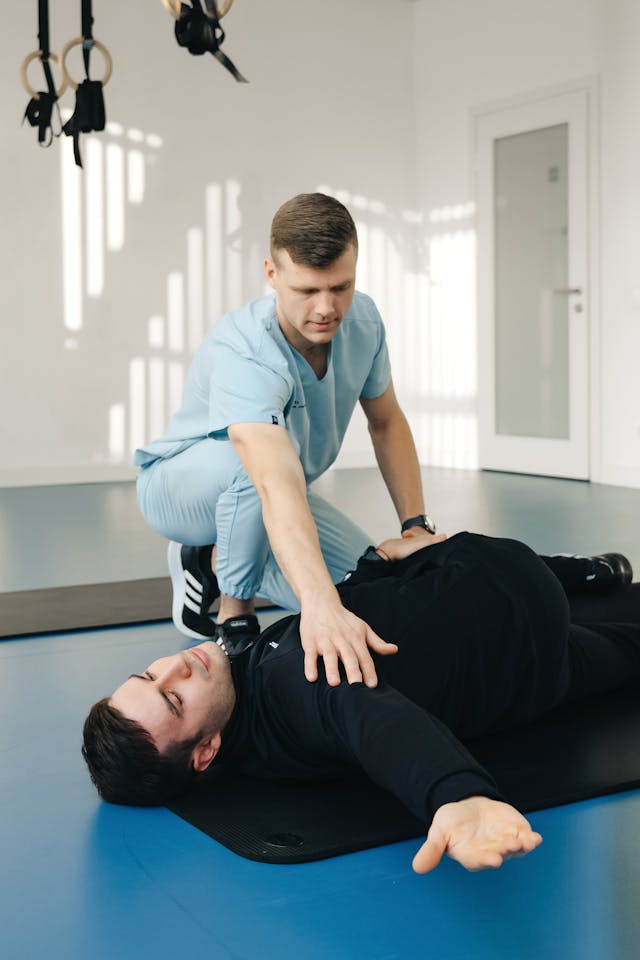Sports Injury Rehabilitation in Medina, OH

Sports injury rehabilitation is an important aspect of athletic recovery, requiring a multifaceted approach tailored to individual needs. Evidence-based practices prioritize restoring strength, flexibility, and functional movements to help athletes return to peak performance. Advances in medical technology, such as wearable devices, enhance monitoring and guarantee compliance with rehabilitation protocols. Psychological interventions are equally essential, fostering mental resilience and motivation. Understanding these components is fundamental to optimizing the rehabilitation journey for athletes.
Understanding the Different Types of Sports Injuries
How exactly do sports injuries manifest in various forms and severities? Sports injuries are typically classified into acute injuries, resulting from sudden trauma, and chronic injuries, which develop over time due to repetitive stress. Injury classification aids in tailoring specific rehabilitation techniques to expedite recovery timelines and minimize performance impact. Acute injuries, such as fractures or sprains, often require immediate intervention, while chronic injuries, like tendinitis, necessitate prolonged treatment. Injury prevention strategies, including strength training and proper technique, play an essential role in mitigating risks. Athlete demographics influence injury prevalence and recovery; younger athletes may recover faster compared to older counterparts. Understanding these variances guarantees patient-focused care, optimizing rehabilitation outcomes and enabling athletes to return to peak performance efficiently.
The Role of Medical Technology in Modern Rehabilitation
While understanding the nature of sports injuries lays the groundwork for effective rehabilitation, the integration of medical technology considerably enhances treatment strategies. Advances such as telehealth solutions and wearable devices have transformed traditional rehabilitation practices. Telehealth facilitates remote consultations, enabling continuous monitoring and timely adjustments to rehabilitation protocols without geographical constraints. This approach guarantees patient compliance and optimizes recovery timelines. Wearable devices, on the other hand, provide real-time data on physiological parameters, such as range of motion and muscle activity. These insights allow clinicians to tailor interventions based on objective metrics, enhancing the precision of therapeutic outcomes. Evidence suggests that incorporating these technologies leads to improved rehabilitation efficiency and patient satisfaction, underscoring their pivotal role in modern sports injury management.
Creating a Personalized Rehabilitation Plan
Developing a personalized rehabilitation plan is vital for optimizing recovery outcomes, as it considers the unique needs and conditions of each patient. This tailored approach begins with thorough assessment methods, including biomechanical analysis and functional screening, to accurately evaluate the extent of injury and functional impairments. By integrating these findings, clinicians can formulate specific, measurable personal goals aligned with the patient’s athletic aspirations and recovery timeline. Evidence-based interventions are chosen to facilitate targeted functional restoration, incorporating flexibility, strength, and proprioceptive training as needed. Continuous monitoring and reassessment are important, allowing for adaptive modifications to the plan that reflect patient progress and evolving goals. This individualized strategy promotes enhanced recovery efficiency and patient adherence, ultimately supporting a successful return to sport.
The Importance of Mental Resilience in Recovery
Mental resilience plays a critical role in sports injury rehabilitation, as it facilitates the process of building mental strength and overcoming psychological barriers. Evidence suggests that patients who actively engage in psychological interventions, such as cognitive-behavioral therapy, exhibit improved outcomes in their recovery journey. Fostering a resilient mindset can enhance adherence to rehabilitation protocols and ultimately expedite functional recovery.
Building Mental Strength
How does mental resilience impact the journey of recovery from a sports injury? Mental resilience is essential in maneuvering the complexities of rehabilitation, markedly influencing recovery outcomes. Evidence suggests that mental visualization techniques aid in accelerating physical healing by engaging neural pathways similar to those activated during physical movement. This cognitive strategy promotes muscle memory and enhances motor coordination. Additionally, the use of positive affirmations can mitigate stress responses, fostering a constructive mindset that bolsters adherence to rehabilitation protocols. Patients equipped with mental resilience are more likely to maintain motivation, thereby optimizing their recovery trajectory. By integrating mental visualization and positive affirmations, individuals enhance their psychological framework, which is vital for overcoming the multifaceted challenges inherent in sports injury rehabilitation.
Overcoming Psychological Barriers
The journey from building mental strength to overcoming psychological barriers is marked by substantial challenges that require targeted strategies. Athletes in rehabilitation often face mental blocks that impede progress. Effective fear management is essential, as apprehensions about re-injury can hinder physical recovery. Evidence-based interventions, such as visualization techniques, have shown efficacy in bolstering confidence and enhancing performance by mentally rehearsing successful outcomes. Additionally, coping strategies tailored to individual needs facilitate emotional resilience, aiding athletes in maneuvering through the emotional turmoil accompanying injury recovery. Techniques like cognitive restructuring help reframe negative thoughts, fostering a more constructive mindset. Ultimately, integrating these psychological tools within rehabilitation protocols not only accelerates physical healing but also fortifies mental resilience, ensuring a more holistic recovery process.
Key Exercises for Restoring Strength and Mobility
In sports injury rehabilitation, key exercises such as progressive resistance training, functional movement patterns, and flexibility and range exercises play a vital role in restoring strength and mobility. Evidence suggests that progressive resistance training enhances muscle hypertrophy and neuromuscular coordination, essential for regaining pre-injury performance levels. Incorporating functional movement patterns and flexibility exercises further guarantees that patients achieve thorough recovery, reducing the risk of re-injury by addressing joint range of motion and biomechanical efficiency.
Progressive Resistance Training
Progressive resistance training serves as a cornerstone in the rehabilitation of sports injuries, systematically enhancing both strength and mobility. Utilizing the principle of progressive overload, this approach involves incrementally increasing resistance to stimulate muscle hypertrophy and neuromuscular adaptations. Evidence-based protocols highlight its role in promoting strength adaptation, essential for restoring functional capacity post-injury. Tailored exercise regimens are designed to target specific muscle groups, ensuring balanced muscle development and joint stabilization. By carefully adjusting load and intensity, therapists can optimize recovery outcomes while minimizing the risk of re-injury. Patient-focused strategies emphasize gradual progression, allowing individuals to safely regain pre-injury performance levels. Consequently, this method is indispensable for athletes aiming to resume competitive activities with restored strength and mobility.
Functional Movement Patterns
Utilizing functional movement patterns is essential for restoring strength and mobility during sports injury rehabilitation. Functional mobility is enhanced through targeted exercises that simulate real-life activities, thereby facilitating a return to pre-injury performance levels. A thorough movement assessment identifies deficits in movement patterns, enabling tailored interventions that address specific impairments. Evidence suggests that incorporating multi-joint, dynamic exercises improves neuromuscular control and joint stability. This approach not only promotes muscle strength but also optimizes motor learning, vital for effective rehabilitation outcomes. By focusing on movements rather than isolated muscles, patients can achieve holistic recovery, reducing the risk of re-injury. The strategic integration of functional movement patterns guarantees that rehabilitative protocols are patient-centric and outcome-oriented, fostering long-term success in athletic populations.
Flexibility and Range Exercises
Flexibility and range of motion exercises are essential components in the rehabilitation of sports injuries, serving to re-establish joint mobility and muscle elasticity. Dynamic stretching, which involves active movements of muscles that bring forth a stretch but are not held in the end position, is vital for warming up tissues and enhancing flexibility. Conversely, static stretching, where a muscle is elongated to its farthest point and held, aids in improving overall muscle length and reducing tension. Conducting flexibility assessments and range testing allows clinicians to pinpoint specific deficits and tailor interventions to individual needs. Evidence suggests that integrating both stretching modalities can expedite recovery by promoting ideal biomechanical function, thereby facilitating a quicker return to pre-injury activity levels.
Nutrition and Recovery: Fueling the Healing Process
When recovering from a sports injury, maximizing nutrition is essential for effective healing and recovery. Implementing precise nutrient timing guarantees that the body receives essential nutrients at ideal intervals, enhancing tissue repair. Adequate protein intake is critical for muscle regeneration, while incorporating anti-inflammatory foods such as omega-3 fatty acids can reduce swelling and pain. Hydration strategies are fundamental; maintaining fluid balance supports cellular functions and accelerates recovery. A well-rounded meal planning approach should emphasize micronutrient balance, providing vitamins and minerals necessary for healing processes. Recovery smoothies can offer a convenient method to deliver a concentrated dose of nutrients. Finally, evidence supports the supplementation benefits of certain nutrients, like vitamin D and omega-3s, in promoting faster rehabilitation from injuries.
Monitoring Progress and Preventing Future Injuries
Effective monitoring of progress is essential in the rehabilitation process, as it provides measurable insights into recovery milestones and identifies areas needing further attention. Clinicians employ progress tracking mechanisms such as functional movement assessments and patient-reported outcome measures. These tools facilitate objective evaluation of recovery trajectories, ensuring interventions are appropriately adjusted. Evidence indicates that structured progress tracking enhances rehabilitation efficacy and accelerates return-to-play timelines.
Injury prevention remains a critical component, necessitating proactive strategies. Implementing individualized exercise regimens focusing on strength, flexibility, and proprioception mitigates recurrent injury risks. Data-driven decision-making, informed by tracking trends, aids in recognizing patterns that predispose athletes to setbacks. By integrating injury prevention protocols with progress tracking, practitioners optimize recovery outcomes and fortify athletes against future injuries, thereby promoting sustained athletic performance.
